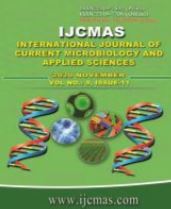


 National Academy of Agricultural Sciences (NAAS)
National Academy of Agricultural Sciences (NAAS)

|
PRINT ISSN : 2319-7692
Online ISSN : 2319-7706 Issues : 12 per year Publisher : Excellent Publishers Email : editorijcmas@gmail.com / submit@ijcmas.com Editor-in-chief: Dr.M.Prakash Index Copernicus ICV 2018: 95.39 NAAS RATING 2020: 5.38 |
A field experiment was conducted to assess the effect of nitrogen levels and cattle urine foliar sprays on growth and yield of maize (Zea mays L.) at Agronomy Farm, College of Agriculture, Pune, during Kharif-2019-20. The experiment consisted of sixteen treatment combinations based on four levels of the recommended dose of nitrogen (@ 0, 50, 75 and 100 %) through urea and four levels of cattle urine foliar spray (@ 0, 5, 10 and 15 %) taken at 25, 45 and 60 DAS replicated thrice in Factorial Randomized Block Design. The results revealed that all the growth characters viz., plant height, number of functional leaves, leaf area and dry matter were found significantly higher with the application of 100% RDN. It was followed by the application of 75% RDN. However, a substantial reduction in growth characters was observed with the application of 0 and 5% RDN. While, cattle urine foliar spray @ 10 % taken at 25, 45 and 60 DAS was found superior for plant height, number of functional leaves and leaf area and dry matter of maize, which was closely followed by 15 % cattle urine foliar spray. The yield contributing characters like weight of the cob with and without husk, length and girth of the cob, number of grain row per cob, number of grains per cob, weight of grains per cob and hundred grain weight were found significantly higher with the application of 100% RDN. The number of cobs per plant was found to be maximum with the application of 100% RDN, which influenced non significantly. Statistically, the higher yield attributes were recorded with a 10% application of cattle urine. The grain and stover yield of maize was influenced significantly due to different levels of nitrogen and the statistically higher grain and stover yield were recorded with the application of 100% RDN. While the application of 10% cattle urine sprays recorded the statistically higher grain and stover yield, which was followed by 15% cattle urine spray.
 |
 |
 |
 |
 |